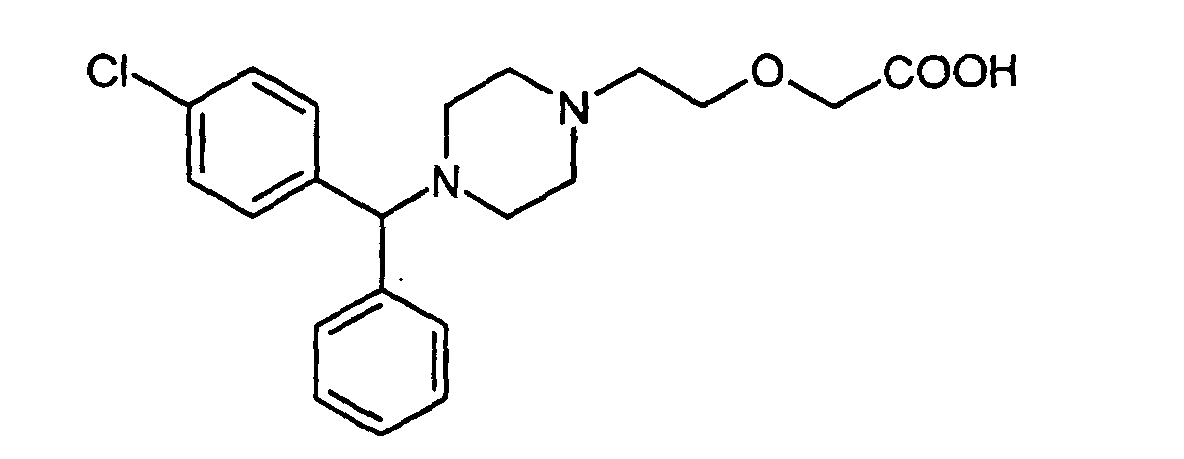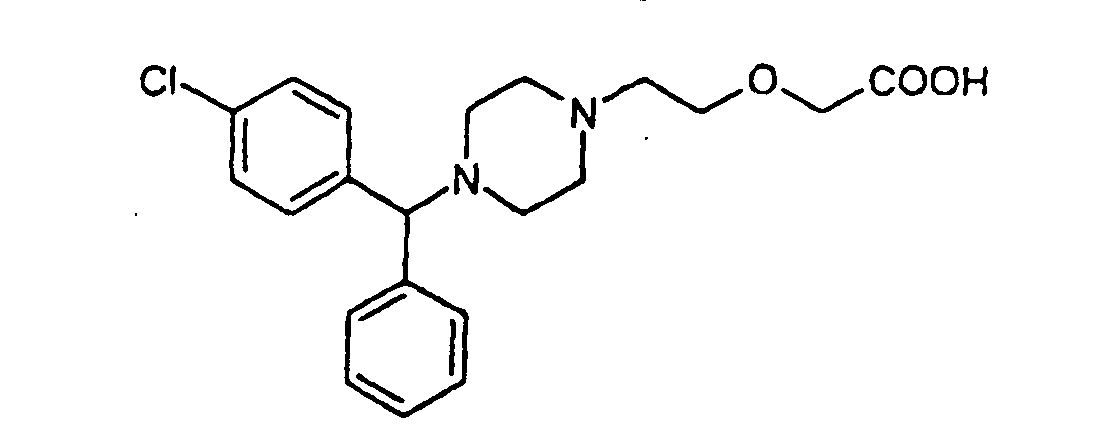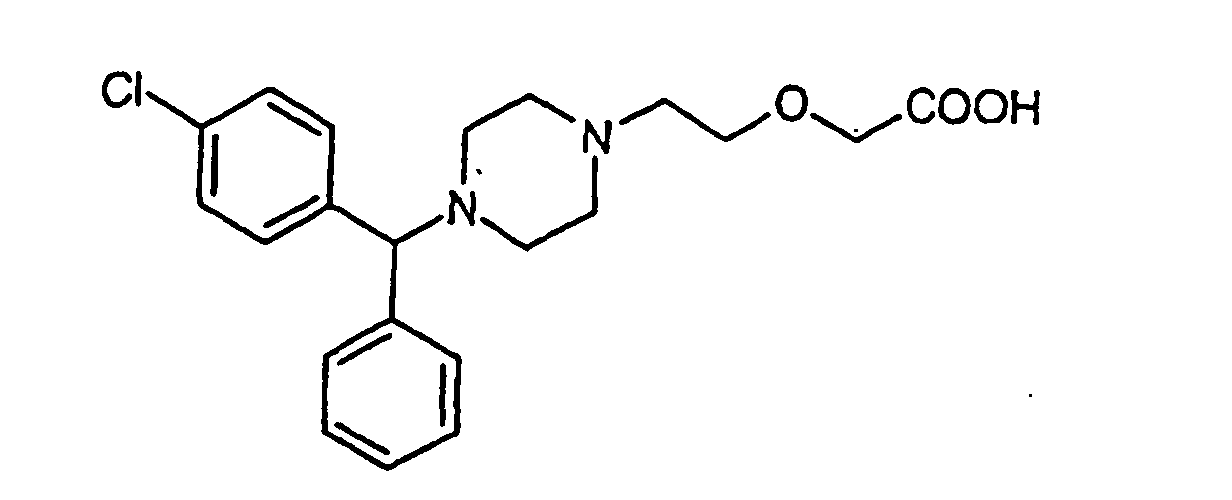|
(11) | EP 1 098 870 B1 |
| (12) | EUROPEAN PATENT SPECIFICATION |
|
|
| (54) |
Nitrate salt of Cetirizine Nitratsalz von Cetirizine Nitrates de Cétirizine |
|
|
|||||||||||||||||||||||||||||||||||
| Note: Within nine months from the publication of the mention of the grant of the European patent, any person may give notice to the European Patent Office of opposition to the European patent granted. Notice of opposition shall be filed in a written reasoned statement. It shall not be deemed to have been filed until the opposition fee has been paid. (Art. 99(1) European Patent Convention). |
[0001] The present invention relates to compounds, or pharmaceutical compositions thereof, for systemic and non systemic use, to be employed in the respiratory system pathology treatment with or without infective etiopathogenetic basis, specifically chronic pulmonary diseases (chronic obstructive pulmonary diseases (COPD)), such as asthma, bronchitis, enphisema, thromboembolism with lower side effects compared with the drugs at present used for the treatment of these pathologies.
[0002] It is known in the art that for the treatment of these pathologies the most used products are Salbutamol, Salmeterol, etc. See for instance the volume "Textbook of Therapeutics - Drugs and Disease Management - 6th Edition 1996" page 685. These products are effective but have the drawback to give side effects in particular towards the cardiovascular apparatus. Said products must be administered with caution to patients suffering from cardiovascular pathologies.
[0003] Other products used in these pathologies as such or as coadjuvants of other medicines are for instance Ambroxol and Bromhexine, the administration of which is accompanied also by the presence of side effects for the gastrointestinal apparatus, such as burnings and gastric sensitiveness.
Hey et al. in Arzneim.-Forsch./Drug Res. 1996, 46(1), pages 153-158 reported a study referred to the evaluation of the arrhythmogenic potential of a series of second generation histamine H1 antagonists, which includes cetirizine hydrochloride, in an experimental model predictive of adverse ECG effects in man. The results showed that in this model cetirizine and other tested drugs were devoid of cardiovascular effects.
[0004] The need was felt to have available compounds and their pharmaceutical compositions, effective in the treatment of respiratory system pathologies, combined with lower side effects for the cardiovascular apparatus and/or the gastrointestinal apparatus.
[0005] The Applicant has unexpectedly and surprisingly found specific compounds and compositions thereof solving the above mentioned technical problem.
[0006] It is an object of the present invention nitrate salts of a compound or their pharmaceutical compositions, to be used for the treatment of respiratory system pathologies, specifically chronic pulmonary diseases (chronic obstructive pulmonary diseases (COPD)) such as asthma, bronchitis, enphisema, thromboembolism, infective pulmonary diseases, said compound being characterized in containing at least a reactive group capable to be salified with nitric acid, said compound is Cetirizine having formula (II)
[0007] In the compositions according to the present invention also optical isomer D or L or the racemic, enantiomer can be used. In general one isomeric form has higher activity with respect to the other, e.g. D form with respect to L form or viceversa.
[0008] The salts of the invention contain at least one nitrate ion mole/mole of the precursor. Preferably the ratio between the moles of nitrate ion and those of the precursor is unity; salts with a higher molar ratio can be obtained when in the molecule there are other amine groups basic enough to form a ionic bond with the nitrate anion.
[0009] The salts of the present invention are formulated in the corresponding pharmaceutical compositions according to the known techniques in the field, together with the usual excipients; see for instance the "Remington's Pharmaceutical Sciences 15a Ed." volume.
The precursor of the salts is prepared acording to the methods described in the Merck Index 14a Ed.
[0011] If the precursor to be used to form the salt according to the invention is available as a free base, or as a corresponding salt, both soluble in an organic solvent preferably not containing hydroxyl groups in the molecule, such as for example acetonitrile, ethyl acetate, tetrahydrofuran, etc., the nitrate salt is prepared by dissolving the substance or its salt in said solvent at a concentration preferably equal or higher than 10% w/v, and then adding the requested amount of concentrated nitric acid, preferably diluted before addition in the same solvent used formerly to dissolve the compound, preferably cooling the mixture during and after said addition at temperatures between 20°C and 0°C, recovering the obtained product by filtration and optionally washing the solid with the same chilled solvent.
[0012] When the precursor or its available salt are slightly soluble in the above mentioned solvent, an hydroxylated solvent is added to said solvent to improve solubility. Examples of such hydroxylated solvent are methyl alcohol, ethyl alcohol and water. Precipitation can be accellerated by diluting with an apolar solvent after nitric acid addition.
[0013] When the precursor is salified with an hydrogen halogenide, the salt with nitric acid can be prepared by adding silver nitrate to the solution of the halogenide in the above solvent. After filtering off silver halogenide, the solution is concentrated and cooled to recover the nitrate salt by precipitation.
[0014] Starting from a salt of the precursor wherein the anion is different from chloride it is however preferable to treat an aqueous solution of said salt with a saturated solution of carbonate or bicarbonate sodium or potassium salt, or with a sodium or potassium hydroxide diluted solution, then extracting the aqueous phase with a suitable organic solvent (for example halogenated solvents, esters, ethers), dehydrating and then evaporating the organic solution, dissolving the thus obtained residue in the above mentioned solvents which do not contain hydroxyl groups, e.g. acetonitrile, or in a mixture of said solvent with an hydroxylated solvent, and then following the aforementioned described preparation methods.
[0015] The salts and compositions of the present invention can be used for systemic administration, for example they can be administered by oral route, such as for expectorants; by intramuscular, intravenous route, etc.; or they can be used for non-systemic administrations, for example as aerosols or topical applications. In general the salts of the invention are used for the same therapeutical applications of the precursors.
[0016] The nitrate salts of the invention have increased general safety in the confront of the precursors.
[0017] The administered doses are those typical of the precursors; however since the products of the invention show a therapeutic effectiveness superior to that of the precursors, they can be used also at doses higher than those of the precursors without giving side effects.
Other applications of the invention products are as antihistamine (antiallergics) for example for ophthalmic applications.They can be administered by systemic or non systemic route, as indicated above, or also in the form of ophthalmic compositions, such as collyria, etc.
EXAMPLE 1
Acute toxicity studies of the invention salts
[0019] The products have been administered in suspension of carboxymethylcellulose 2% by weight to groups of 10 mice each
[0020] The salt acute toxicity was evaluated by oral administration of single doses of the compounds to groups of 10 rats each, increased up to 100 mg/Kg.
[0021] The animals were kept under observation for 14 days, recording the lethality incidence and the appearance of toxic symptoms.
EXAMPLE 2
Cetirizine nitrate salt preparation
[0023] The salt is prepared by adding to a solution of Cetirizine (2 g, 5.14 mmoles) in a solvent mixture made of acetonitrile (10 ml) and tetrahydrofuran (5 ml), 1,23 ml of the solution of nitric acid in acetonitrile (3.5 ml taken from a solution obtained by adding acetonitrile to 2.7 ml of nitric acid 65% and bringing to the final volume of 10 ml with acetonitrile). An amorphous solid is obtained which at the elemental analysis corresponds to the nitrate salt of Cetirizine:
| C | H | N | Cl | |
| Calculated | 55.81% | 5.79% | 9.29% | 7.84% |
| found | 55.84% | 5.75% | 9.22% | 7.83% |
PHARMACOLOGICAL TESTS
EXAMPLE 3
Antihistaminic activity in the guinea pig of Cetirizine nitrate and Cetirizine hydrochloride - studies on the experimental bronchoconstriction
[0024] The animals were prepared according to the method of Del Soldato et Al., J. Pharmacol. Methods 5 279 1981 for the cardiorespiratory activity surveying. 0.1 ml of a histamine saline solution (2 µg/Kg) was injected by intravenous route to the animals. Three groups were formed, each group consisting of 8 animals. Cetirizine nitrate, Cetirizine hydrochloride, or the vehicle alone, were administered endovenously at a dose of 77 µmoles/µg
[0025] The tidal air variation before and after the capsaicin administration was measured by a Konzett apparatus modified as described in the above mentioned Del Soldato reference, connected to a polygraphic system.
1. Nitrate salt of Cetirizine having formula (II)

and enantiomers, racemic mixtures thereof.
and enantiomers, racemic mixtures thereof.
2. A nitrate salt according to claim 1 wherein the salt of said compound contains at
least one mole nitrate ion/ mole of compound.
3. Pharmaceutical compositions comprising a compound according to claim 1 and a pharmaceutical
acceptable excipient.
4. A nitrate salt according to claim 1 for use as a medicament.
5. Use of nitrate salts according to claim 1 for manufacturing a medicament for the treatment
of respiratory system pathologies.
6. Use of nitrate salts according to claim 1 for manufacturing a medicament for the treatment
of allergies.
7. Use of a nitrate salt according to claim 1 for manufacturing a medicament for the
treatment of asthma.
8. The pharmaceutical composition of claim 3, wherein the composition is in a form that
can be administered by non systemic administration.
9. The pharmaceutical composition of claim 8, wherein the composition is in a form that
can be administered as an aerosol.
10. The pharmaceutical composition of claim 3, wherein the composition is in a topically
administrable form.
1. Nitratsalze von Cetirizin, das die Formel (II) hat:

und Enantiomere, racemisches Gemisch davon.
und Enantiomere, racemisches Gemisch davon.
2. Nitratsalz nach Anspruch 1, wobei das Salz der Verbindung wenigstens ein Mol Nitration/Mol
Verbindung enthält.
3. Pharmazeutische Zusammensetzungen, die eine Verbindung nach Anspruch 1 und ein pharmazeutisch
akzeptables Exzipiens umfassen.
4. Nitratsalz nach Anspruch 1 zur Verwendung als Medikament.
5. Verwendung von Nitratsalzen nach Anspruch 1 zur Herstellung eines Medikaments für
die Behandlung von Pathologien des Atemtrakts.
6. Verwendung von Nitratsalzen nach Anspruch 1 zur Herstellung eines Medikaments für
die Behandlung von Allergien.
7. Verwendung eines Nitratsalzes nach Anspruch 1 zur Herstellung eines Medikaments für
die Behandlung von Asthma.
8. Pharmazeutische Zusammensetzung nach Anspruch 3, wobei die Zusammensetzung in einer
Form ist, die durch nichtsystemische Verabreichung verabreicht werden kann.
9. Pharmazeutische Zusammensetzung nach Anspruch 8, wobei die Zusammensetzung in einer
Form ist, die als Aerosol verabreicht werden kann.
10. Pharmazeutische Zusammensetzung nach Anspruch 3, wobei die Zusammensetzung in einer
topisch verabreichbaren Form ist.
1. Sel nitrate de cétirizine de formule (II)

et énantiomères et mélange racémique de celui-ci.
et énantiomères et mélange racémique de celui-ci.
2. Sel nitrate selon la revendication 1, dans lequel le sel dudit composé contient au
moins une mole d'ion nitrate/mole de composé.
3. Compositions pharmaceutiques comprenant un composé selon la revendication 1 et un
excipient pharmaceutiquement acceptable.
4. Sel nitrate selon la revendication 1 pour une utilisation en tant que médicament.
5. Utilisation du sel nitrate selon la revendication 1 pour la fabrication d'un médicament
pour le traitement des pathologies du système respiratoire.
6. Utilisation du sel nitrate selon la revendication 1 pour la fabrication d'un médicament
pour le traitement des allergies.
7. Utilisation d'un sel nitrate selon la revendication 1 pour la fabrication d'un médicament
pour le traitement de l'asthme.
8. Composition pharmaceutique de la revendication 3, laquelle composition est sous une
forme qui peut être administrée par voie non systémique.
9. Composition pharmaceutique de la revendication 8, laquelle composition est sous une
forme qui peut être administrée en tant qu'aérosol.
10. Composition pharmaceutique de la revendication 3, laquelle composition est sous une
forme administrable par voie topique.
